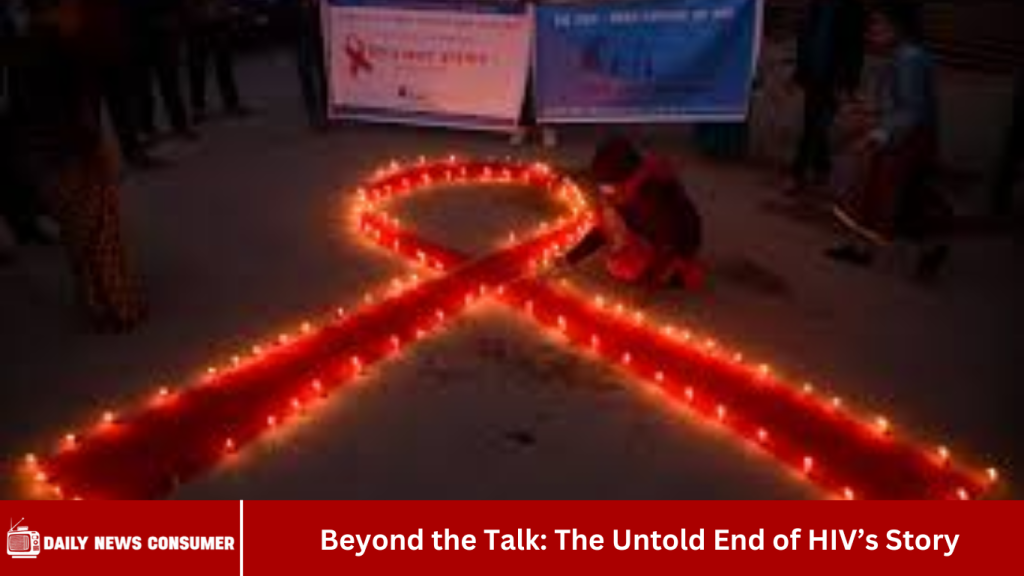Hi everyone! How are you all doing? Welcome to www.dailynewsconsumer.com! For decades, HIV/AIDS dominated global health discussions, fueled by fear, stigma, and scientific urgency. Yet, as medical advancements transform HIV from a death sentence into a manageable condition, the conversation has faded from public discourse. But silence does not mean resolution.
Beyond the Talk: The Untold End of HIV’s Story explores why the dialogue has dwindled, the lingering challenges, and what true “ending” to the HIV epidemic really means. Is it the absence of deaths? The elimination of transmission? Or the eradication of stigma?
This article delves into the untold realities of HIV today—medical triumphs, persistent inequalities, and the silent battles still being fought.
The Rise and Fall of the HIV Conversation
1. The Height of the Crisis (1980s–1990s)
The emergence of HIV/AIDS in the early 1980s triggered panic, discrimination, and activism. Governments were slow to respond, leaving marginalized communities—particularly gay men, sex workers, and drug users—to bear the brunt. Grassroots movements like ACT UP demanded action, leading to faster drug approvals and increased funding.
2. The Breakthrough Era (2000s–2010s)
The introduction of antiretroviral therapy (ART) in the mid-1990s turned HIV into a chronic condition rather than a fatal disease. By the 2010s, advancements like PrEP (pre-exposure prophylaxis) allowed high-risk individuals to prevent infection. The global HIV conversation shifted from crisis to control.
3. The Fading Dialogue (2020s and Beyond)
Today, HIV rarely makes headlines in wealthy nations. With effective treatments available, public attention has waned. But this silence masks ongoing struggles:
- Global disparities – While wealthy countries have near-zero AIDS-related deaths, sub-Saharan Africa still accounts for two-thirds of new infections.
- Stigma persists – Many still face discrimination, discouraging testing and treatment.
- Funding declines – Donor fatigue threatens progress in hard-hit regions.
HIV hasn’t ended—it’s just been forgotten by those no longer directly affected.
The Medical Triumphs: How Close Are We to Ending HIV?
1. Treatment as Prevention (TasP)
Studies confirm that people with undetectable viral loads (thanks to ART) cannot transmit HIV sexually (U=U: Undetectable = Untransmittable). This has revolutionized prevention.
2. Pre-Exposure Prophylaxis (PrEP)
Daily PrEP pills reduce HIV risk by over 99% for high-risk individuals. New long-acting injectable versions (like Cabotegravir) are making prevention even easier.
3. The Quest for a Cure
While no cure exists, breakthroughs like the Berlin Patient (the first person cured via stem cell transplant) and mRNA vaccine research offer hope.
Yet, despite these advances, millions still lack access to basic HIV care.
The Unfinished Battle: Where HIV Still Thrives
1. Geographic Disparities
- Sub-Saharan Africa remains the epicenter, with 1 in 25 adults living with HIV.
- Eastern Europe and Central Asia see rising cases due to stigma and poor healthcare access.
2. Vulnerable Populations
- Young women and girls (especially in Africa) face high infection rates due to gender inequality.
- LGBTQ+ communities, sex workers, and drug users still experience criminalization and lack of care.
3. The Mental Health Crisis
Many long-term survivors face “post-AIDS syndrome”—chronic pain, depression, and trauma from decades of survival.
The Silent Struggles: Stigma and Complacency
1. The “It’s Over” Myth
Because HIV is no longer a death sentence, many assume the fight is won. This complacency risks resurgences in cases.
2. The Stigma That Never Left
- Many avoid testing due to fear of discrimination.
- Laws still criminalize HIV non-disclosure in some countries.
3. The Funding Crisis
Global HIV funding has plateaued, with some donors shifting focus to other diseases. Without sustained investment, progress could reverse.
The Path Forward: What Does “Ending HIV” Really Mean?
1. Zero New Infections
This requires universal testing, treatment, and PrEP access—especially in high-burden regions.
2. Zero Deaths
Eliminating AIDS-related deaths means ensuring no one is left behind due to poverty or discrimination.
3. Zero Stigma
Until HIV is free from shame, the epidemic’s social toll will persist.
4. A Cure or Vaccine
While current tools are powerful, a cure or vaccine would be the ultimate endgame.
Frequently Asked Question
Is HIV still a deadly disease?
No—with proper treatment, people with HIV can live long, healthy lives. However, without access to medication, it remains fatal.
Can HIV be cured?
Not yet, but treatments can suppress the virus to undetectable levels, and research into cures is ongoing.
How effective is PrEP?
When taken correctly, PrEP is over 99% effective at preventing HIV.
Why are HIV rates still high in Africa?
Due to healthcare gaps, poverty, gender inequality, and stigma, many still lack access to prevention and treatment.
Is HIV still stigmatized today?
Yes—many people with HIV face discrimination in healthcare, workplaces, and relationships.
How close are we to an HIV vaccine?
Several trials are underway, but an effective vaccine is likely still years away.
What can be done to truly end HIV?
- Expand testing and treatment access
- Fund global health programs
- Combat stigma and inequality
- Support cure research
Conclusion
While much progress has been made in the fight against HIV, Beyond the Talk: The Untold End of HIV’s Story reminds us that awareness alone isn’t enough. True change comes from sustained action, equitable access to healthcare, and dismantling the stigma that still surrounds the virus. By moving past the surface-level conversation and addressing the structural, social, and personal barriers that remain, we edge closer to a future where HIV is no longer a threat. The end of HIV’s story isn’t written yet—but with collective effort, compassion, and innovation, we can ensure it’s a hopeful one.

